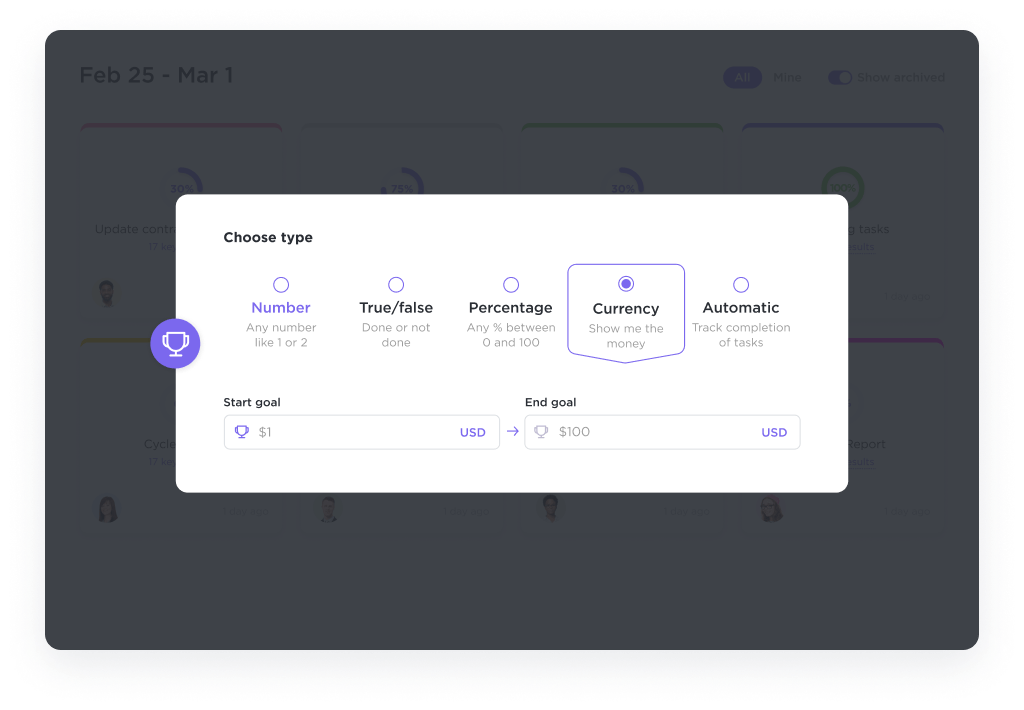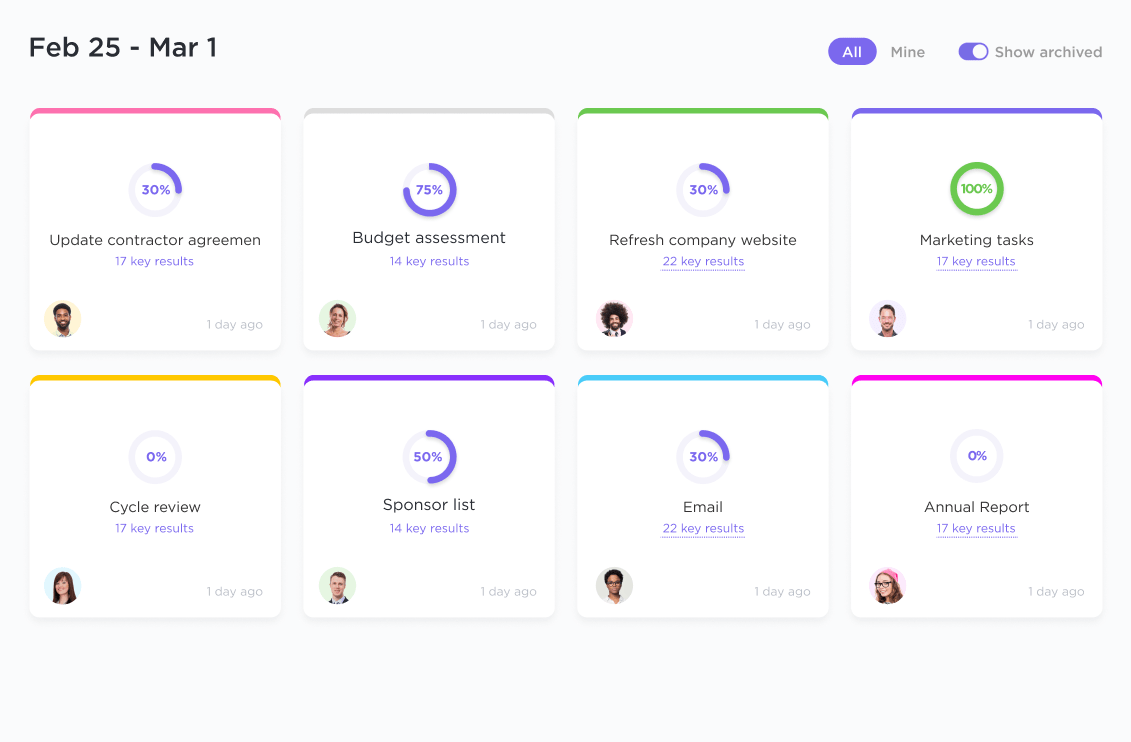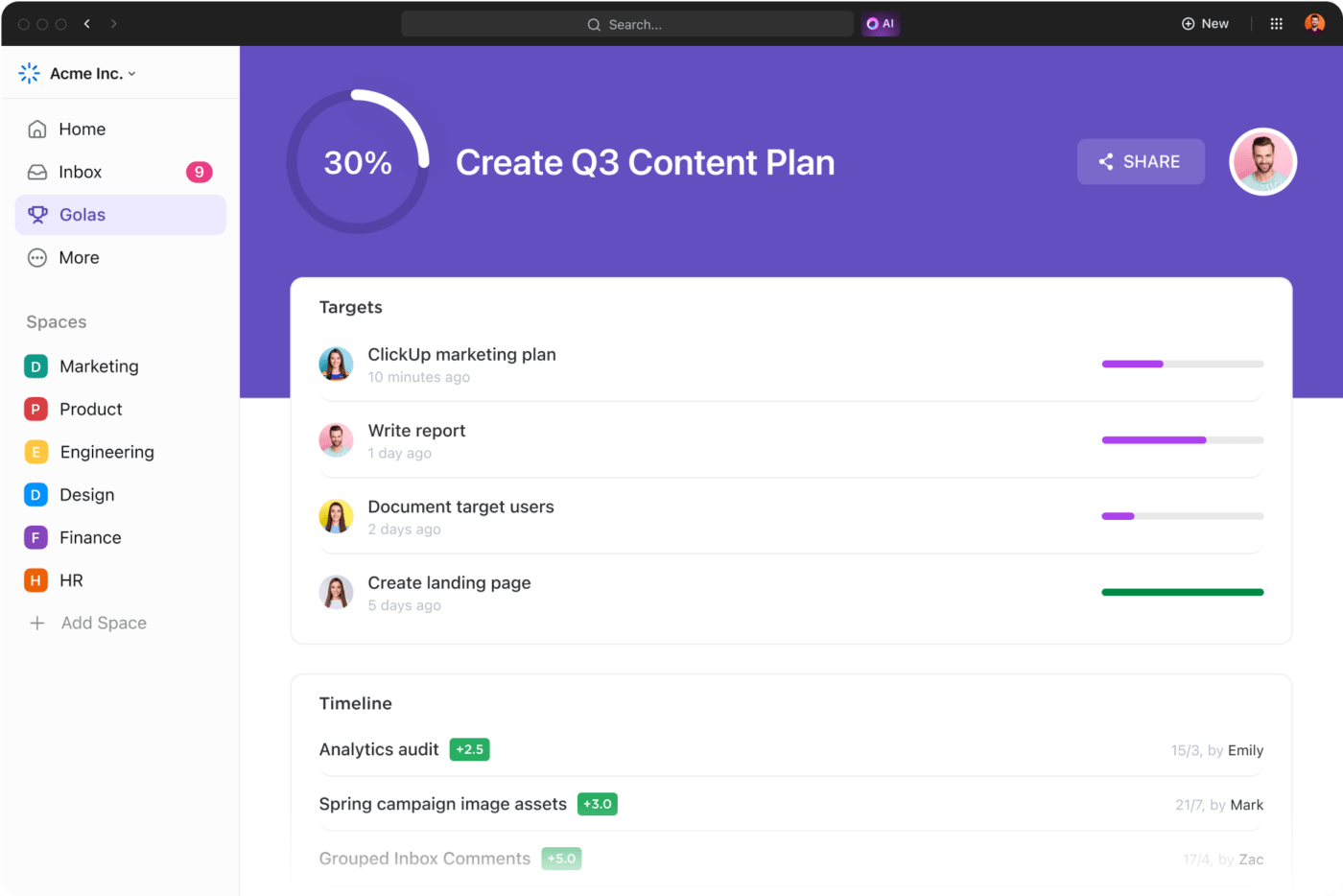التخطيط جزء أساسي من إعداد المشروع. ومع ذلك، فحتى أفضل الخطط الموضوعة سرعان ما تنحرف عن مسارها دون هدف واضح.
وهنا تدخل أهداف المشروع في دائرة الضوء.
فأهداف المشروع هي البوصلة التي تحافظ على تركيز فريق المشروع ومواءمته. فهي تساعد على تركيز جهود الجميع في مسعى مشترك وتحافظ على عمل الفرق في نفس الاتجاه. إليك نظرة مفصلة على أهداف المشروع وكيفية وضع أهداف رائعة!
ما هو هدف المشروع؟
هدف المشروع هو بيان يساعد على تحديد وتوثيق النتيجة أو النتيجة المرجوة من المشروع. إنه الفكرة أو الفكرة الأساسية التي بدأت المشروع.
ومثل أي هدف آخر، يجب أن تتناسب أهداف المشروع مع إطار عمل SMART لتكون أكثر فعالية. SMART هو أسلوب لتحديد الأهداف يتطلب أن تكون أهداف المشروع:
- محددة: محددة بشكل جيد وواضحة بحيث يمكن مواءمة الفرق وتجنب سوء الفهم
- قابلة للقياس: قابلة للقياس الكمي من خلال وضوحمقاييس المشروع لتتبع التقدم المحرز وقياس النجاح وإجراء التدخلات اللازمة
- قابلة للتحقيق: واقعية وقابلة للتحقيق ضمن نطاق المشروع والقيود المفروضة على الموارد لمنع الإنهاك أو الإحباط
- ذات صلة بالموضوع: مرتبط بأهداف العمل الشاملة بحيث يساهم كل مشروع في تحقيق النجاح المؤسسي الشامل
- محدد بوقت محدد: وجود إطار زمني أو موعد نهائي واضح لخلق شعور بالإلحاح وتحديد أولويات المهام مع الحفاظ على التركيز
لنفترض أنك لاحظت وجود فجوة في السوق بالنسبة للحوم الوهمية النباتية. سيكون تطوير ثلاثة منتجات مختلفة من اللحوم الوهمية النباتية وإطلاقها لجمهورك المستهدف في غضون الأشهر الستة المقبلة هدفاً للمشروع.
وبالمثل، ربما تلاحظ أوقات انتظار طويلة في قسم خدمة العملاء. قد يكون هدف المشروع هو تقليل أوقات الانتظار بنسبة 25%.
هذه مجرد أمثلة قليلة لنبدأ بها. في الأقسام اللاحقة، سنستكشف أمثلة أهداف المشروع بالتفصيل.
أهداف المشروع مقابل أهداف المشروع
أهداف المشروع هي بيانات طموحة وعالية المستوى تسلط الضوء على خطط المشروع. قد يبدو هذا مشابهًا لأهداف المشروع. ففي النهاية، أهداف المشروع هي أيضًا إجراءات محددة وقابلة للقياس تساهم في تحقيق هدف المشروع. قد تؤدي هذه العلاقة الوثيقة إلى استخدام مديري المشاريع للمصطلحين بالتبادل.
ومع ذلك، هناك فرق بين هدف المشروع وغاية المشروع. فالأول هو الحالة النهائية، في حين أن الثاني هو الطريق للوصول إلى هناك. وبطبيعة الحال، من شأن ذلك أن يجعل أهداف المشروع أكثر تحديدًا وأكثر قابلية للتنفيذ، وفي الوقت نفسه قابلة للقياس الكمي والنوعي مقارنة بأهداف المشروع التي يمكن أن تكون غامضة.
إليك مثال سريع:
- هدف المشروع: تقليل أوقات انتظار العملاء بنسبة 25%
- هدف المشروع: هدف المشروع: تنفيذ نظام جديد لقائمة انتظار المكالمات لتحسين كفاءة إدارة المكالمات، وزيادة عدد الموظفين بنسبة 15% للتعامل مع زيادة حجم المكالمات، وتحسين جداول الموظفين خلال أوقات ذروة المكالمات
## أهمية أهداف المشروع أهداف إدارة المشروع توفر اتجاهًا وهدفًا وتركيزًا واضحًا. فهي تحقق مواءمة فريق المشروع، وتضع استراتيجية لتخصيص الموارد، وتساعد في إدارة المواعيد النهائية. بكلمات بسيطة، أهداف المشروع هي أساس النجاح التنظيمي. إليك نظرة أكثر تعمقًا على ما يقدمه هدف المشروع:
- تعزز المشاريع: يوفر التوجيه والتركيز، مما يضمن توافق الجميع لتحقيق الهدف المشترك والنتيجة المرجوة
- يشحذ عملية اتخاذ القرار: يعمل كإطار عمل لأهداف المشروع، مما يساعد على اتخاذ قرارات مستنيرة طوال فترة المشروع
- يعزز تخصيص الموارد: وجود هدف واضح، وإنجازات محددة بشكل جيد، وجدول زمني محدد يساعد مدير المشروع على تحديد الأولويات وتخصيص الموارد
- يحسّن التواصل: يعمل بمثابة لغة مشتركة لأصحاب المصلحة، بغض النظر عن دورهم أو خلفياتهم أو قدراتهم، لتعزيز العمل الجماعي والتعاون
- يُثري ثقافة العمل: العمل من أجل تحقيق هدف مشترك يجمع الفرق معًا لخلق شعور بالوحدة والانتماء في بيئة من الشفافية

أهداف المشروع تحقق التوافق المؤسسي الشامل
- ترفع معنويات الفريق: يخلق إحساسًا بالهدف والتحفيز بينما يضع هدف المشروع موضع التنفيذ لتحقيق النتائج المرجوة، مما يحفز أعضاء الفريق
- يحدد النجاح: يأتي مع المعايير والمعالم التي تساعد فيتقييم المشروع للتقدم والأداء لقياس النجاح
- يرفع من تجربة العملاء: التجارب الإيجابية تعزز ولاء العملاء مع تحسين فرص الإحالات
## فهم أهداف المشروع وغاياته من خلال الأمثلة
نحن نشارك بعض الأمثلة على أهداف المشروع وغايات المشروع التي يمكنك إضافتها إلى قوالب تحديد الأهداف للرجوع إليها. لقد حاولنا أن نكون شاملين قدر الإمكان وأن نغطي مختلف الاحتمالات التي قد يكون فيها تحديد الأهداف بارزاً.
لا تتردد في تعديلها بناءً على متطلباتك. نأمل أن تلهمك هذه القائمة من أمثلة أهداف المشروع لوضع أهداف واقعية للمشروع.
لذا، دعنا نبدأ:
أهداف المشروع للموظفين
الموظفون المتفاعلون والراضون هم العمود الفقري لنجاح الأعمال التجارية. لذا، فإن هدف المشروع الذي يركز على الموظفين سيبدو كالتالي:
مثال على الهدف رقم 1: زيادة مستويات مشاركة الموظفين
أهداف المشروع:
- إجراء استطلاعات ربع سنوية لرضا الموظفين لتحديد مجالات التحسين وتحسين درجات رضا الموظفين بنسبة 5%
- تقديم ترتيبات عمل مرنة مثل العمل عن بُعد أو ساعات العمل المرنة لتحسين التوازن بين العمل والحياة الشخصية
- تعزيز بيئة عمل إيجابية وشاملة تساعد الموظفين على تحقيق أهدافهم الشخصية
مثال على الهدف رقم 2: تحسين معنويات الفريق وتحفيزه
أهداف المشروع:
- تنظيم أنشطة ربع سنوية لبناء الفريق على أساس التواصل وحل المشكلات لتحسين تعاون الفريق ومعنوياته
- تنفيذ برنامج سنوي للتقدير والمكافآت لتقدير جهود الفريق والحفاظ على تحفيز الفريق
- إجراء اجتماعات فردية أسبوعية مع أعضاء الفريق لتقديم ملاحظات بناءة وفرص للتطوير
مثال الهدف رقم 3: زيادة معدلات الاحتفاظ بالموظفين
أهداف المشروع:
- تطوير برنامج تأهيل وتدريب شامل مدته 90 يومًا للموظفين الجدد
- توسيع فرص التطوير المهني والنمو الوظيفي
- استحداث برنامج إرشادي لتشجيع تبادل المعرفة وتنمية المهارات
أهداف المشروع للعملاء
غالبًا ما يركز هدف المشروع للعملاء على تعزيز تجربة العملاء وكسب ولائهم وتحقيق رضاهم. فيما يلي بعض الأمثلة على هذه الأهداف:
مثال على الهدف رقم 4: توسيع قاعدة العملاء
أهداف المشروع:
- تحليل بيانات العملاء لاكتشاف شرائح جديدة وغير مستغلة في السوق وزيادة انتشار السوق بنسبة 10% في الربع القادم
- ابتكار حملة تسويقية استراتيجية وموجهة للوصول إلى 1000 عميل جديد في الأشهر الثلاثة المقبلة
- إطلاق برنامج جذاب للإحالة لتشجيع التسويق الشفهي لزيادة اكتساب العملاء بنسبة 15% من خلال الإحالات
مثال الهدف رقم 5: زيادة القيمة الدائمة للعميل
أهداف المشروع:
- مراقبة سلوك العميل الشرائي واتجاهاته للتنبؤ باحتمالية البيع، وإنشاء قائمة بالمحفزات، وتحديد النية
- تحديد واستغلال فرص البيع العابر والبيع الإضافي لزيادة متوسط قيمة الطلبات بنسبة 20%
- تنفيذ منصة إدارة علاقات العملاء (CRM) لإضفاء الطابع الشخصي على العلاقات مع العملاء
مثال على الهدف رقم 6: تعزيز رضا العملاء
أهداف المشروع:
- إضفاء الطابع الشخصي على تجربة العملاء باستخدام تحليل البيانات لرفع درجات رضا العملاء بمقدار 20 نقطة
- تحسين وقت الاستجابة لخدمة العملاء بنسبة 20% باستخدام روبوت محادثة مدعوم بالذكاء الاصطناعي
- الحصول على ملاحظات العملاء والعمل على رؤى عالية التأثير وذات أولوية عالية
أهداف المشروع للعمليات
هل تتطلع إلى تبسيط سير العمل والعمليات لتعزيز الكفاءة والفعالية من حيث التكلفة؟ إليك بعض الأهداف الذكية التي يمكنك وضعها لتحقيق أهداف العمل هذه:
مثال على الهدف رقم 7: زيادة الكفاءة التشغيلية وقابلية التوسع
أهداف المشروع:
- أتمتة 40٪ من المهام الروتينية والمتكررة لتقليل الجهد اليدوي بنسبة 20٪ في الأشهر الستة المقبلة
- تحليل ثلاث عمليات تجارية أساسية، وتحديد الاختناقات، وإجراء التحسينات من أجل سير عمل أكثر سلاسة
- دمج تكنولوجيا جديدة لزيادة جهود الموظفين وزيادة الإنتاجية بنسبة 15% في غضون عام
مثال على الهدف رقم 8: تقليل التكاليف التشغيلية
أهداف المشروع:
- تحديد وإلغاء ما لا يقل عن 10% من النفقات المهدرة أو غير الضرورية في الأشهر الثلاثة القادمة
- تحويل ما لا يقل عن أربع عمليات مكلفة وغير مرنة وغير فعالة رقميًا
- خفض تكاليف المرافق بنسبة 10% عن طريق تتبع أنماط استهلاك الموارد أو استخدامها
مثال على الهدف رقم 9: تحسين إدارة المخزون
أهداف المشروع:
- الاستفادة من برمجيات إدارة المخزون للحصول على رؤية واضحة لمستويات المخزون وتتبعها
- تحسين علاقات الموردين لضمان تسليم المواد الخام أو المنتجات في الوقت المناسب
- صقل استراتيجيات التسعير لتفريغ المخزون الزائد بنسبة 10% لتقليل تكاليف الحمل أو الاحتفاظ وزيادة الإيرادات بنسبة 5%
أهداف المشروع المالية

استخدم ClickUp لتحديد أهدافك المالية بسهولة
إذا كنت تهدف إلى زيادة الإيرادات، وتقليل النفقات التشغيلية العامة، وتحسين الربحية، وتحسين التدفق النقدي ضمن ميزانية المشروع، ففكر في إضافة الأمثلة التالية إلى عملية تحديد الأهداف
مثال الهدف رقم 10: تأمين تمويل إضافي/رأس مال إضافي
أهداف المشروع:
- وضع خطة شاملة للمشروع في غضون الأشهر الثلاثة المقبلة وتعميم الوثيقة على أصحاب المصلحة
- تحديد ما لا يقل عن 25 مستثمرًا محتملًا أو صاحب رأس مال مغامر أو مستثمرًا ملاكًا والبدء في الاتصال وبناء العلاقات خلال الشهرين المقبلين
- إعداد التوقعات والتنبؤات المالية للربع الأخير من العام
مثال على الهدف رقم 11: تحسين التدفق النقدي
أهداف المشروع:
- التفاوض على شروط دفع أفضل مع الموردين والصفقات مع البائعين لتخفيض الحسابات المستحقة الدفع بنسبة 10% في الأشهر الثلاثة المقبلة
- تقليل تكاليف الحمل أو الاحتفاظ بنسبة 10% في الربع القادم من خلال الإدارة الفعالة للمخزون
- خفض متوسط أيام المبيعات غير المسددة (DSO) بنسبة 12% من خلال الفواتير والتحصيل الفعال كل أربعة أشهر
مثال على الهدف رقم 12: زيادة الربحية
أهداف المشروع:
- إطلاق منتجين أو خدمتين جديدتين على الأقل لتوليد إيرادات تبلغ حوالي 250 ألف دولار في الأشهر الستة المقبلة
- خفض النفقات التشغيلية غير الأساسية بنسبة 10% في الأشهر الثلاثة المقبلة
- إدخال التسعير الديناميكي وتجميع المنتجات لزيادة هوامش الربح بنسبة 15%
أهداف المشروع التكنولوجي
هل تريد الاستفادة من التكنولوجيا لتعزيز الابتكار وتحسين العمليات التجارية وتعزيز الأمن والاستفادة من النمو المتسارع؟ إليك بعض أهداف إدارة المشاريع لهذه الأهداف التجارية:
مثال على الهدف رقم 13: تحسين البنية التحتية لتكنولوجيا المعلومات
أهداف المشروع:
- نقل 70% على الأقل من البنية التحتية لتكنولوجيا المعلومات إلى السحابة خلال العام المقبل
- ترقية أجهزة وبرامج الخوادم الأساسية ومعدات الشبكة لزيادة سرعة النظام بنسبة 25%
- تنفيذ جدار حماية متقدم وأنظمة كشف التسلل لخفض الحوادث الأمنية بنسبة 30%
مثال على الهدف رقم 14: تحسين تطبيقات البرمجيات وجعلها مركزية
أهداف المشروع:
- تطوير حلول برمجية مخصصة لتلبية أهداف عمل محددة
- دمج النظام البيئي الرقمي عن طريق استبدال الأدوات والمنصات والأنظمة المتباينة بمنصة مركزية لإدارة المشاريع
- توفير الدعم الفني المستمر والتدريب على البرمجيات لـ 80% من الموظفين
مثال على الهدف رقم 15: تعزيز أمن البيانات والخصوصية
أهداف المشروع:
- إجراء عمليات التدقيق الأمني واختبارات الثغرات الأمنية كل أسبوعين
- تقديم برامج تدريب إلزامية للموظفين على الأمن السيبراني وجدولة التقييمات كل شهر
- تطوير خطة شاملة للاستجابة لاختراق البيانات يتم تفعيلها خلال 24 ساعة من وقوع الحادث
أفضل الممارسات لتحديد أهداف المشروع وغاياته
تحديد الأهداف الفعالة هو مفتاح تحقيق النتيجة المرجوة. وللتحوط من الرهانات لصالحك، إليك بعض أفضل الممارسات التي يمكنك اتباعها لتحديد الأهداف التي تحسن من فرصك في الوصول إلى الهدف:
- تعاون مع أصحاب المصلحة الرئيسيين أثناء تحديد الأهداف لاكتساب وجهات نظر عملية ومتعددة الأبعاد وضمان موافقة الجميع
- قم بتوصيل الأهداف بوضوح لإبقاء الفريق متوافقاً ومطلعاً على المستجدات
- تطوير نظام ل تحديد أولويات الأهداف حتى تتمكن من التركيز على الأهداف الأكثر أهمية لنجاح المشروع وتخصيص الموارد وفقًا لذلك
- إنشاء مزيج من الأهداف قصيرة الأجل وطويلة الأجل والغايات للحفاظ على الزخم
- تتبعمؤشرات الأداء الرئيسية لإدارة المشاريع لقياس التقدم المحرز وتحديد مجالات التحسين

تصور تقدم الأهداف كمًا ونوعًا باستخدام ClickUp
- تقييم الأهداف بشكل مستمر وإجراء التعديلات اللازمة بشكل دوري بناءً على الظروف المتغيرة أو أداء المشروع
- استخدم أدوات مثل مخططات جانت أو لوحات كانبان لتصور الأهداف والتبعيات
- تحليل المشاريع السابقة للتفكير في كيفية وضع الأهداف وتحسينها بشكل متكرر
- استفد من المعايير الموحدةقوالب إدارة المشاريع حيثما أمكنك للحفاظ على الكفاءة والاتساق في تحديد الأهداف
## أخطاء يجب تجنبها أثناء تحديد أهداف المشروع وغاياته
بعد أن قمنا بتغطية أفضل الممارسات المتعلقة بالأهداف، من الضروري أيضًا مراجعة بعض الأخطاء الشائعة المرتبطة بها. فيما يلي قائمة ببعض الأخطاء التي يجب تجنبها:
- عدم تحديد هدف SMART يمكن أن يؤدي إلى الارتباك وعدم التوافق بين أعضاء الفريق. حتى لو لم تتمكن من تغطية جميع معايير SMART، حاول أن تجعل الهدف محددًا وقابلًا للقياس ومحددًا بوقت محدد لفهم واضح
- وضع أهداف غير قابلة للتحقيق. في حين أنه لا ضير في أن تكون طموحًا، إلا أن الأهداف غير الواقعية يمكن أن تثبط من عزيمة الفريق وتعيق التقدم
- عدم تحديد المواعيد النهائية وإهمال الجداول الزمنية يمكن أن يؤدي إلى المماطلة وعدم تحقيق الأهداف
- إعلان الكثير من أهداف المشروع وغاياته حيث يمكن أن يؤدي ذلك بسهولة إلى إرباك أعضاء الفريق واستغلال موارد أكثر من المطلوب
- الفشل في مواءمة الأهداف مع الأهداف الشاملةإدارة المشاريع المؤسسية استراتيجيات وأهداف الشركة
- تجميع أهداف متعددة معًا ، بغض النظر عن التبعيات أو متطلبات الموارد لخلق طريق مسدود
تحديد أهداف المشروع وتجاوزها باستخدام ClickUp
ClickUp هو برنامج مجاني كامل المواصفات لإدارة المشاريع غني عن التعريف. نظرًا لأن هذا الحل المتكامل يعزز كل جانب من جوانب إدارة المشاريع، فمن الطبيعي أن يكون أيضًا حليف كل مدير مشروع لتحديد الأهداف.
يمكن لأي مدير مشروع تولي مسؤولية هدف إدارة المشروع الخاص به باستخدام أهداف ClickUp .

تعيين أهداف SMART على ClickUp وتوصيل هذه الأهداف عبر الفرق
تعمل هذه الأداة المخصصة على تسهيل الفهم الواضح لأهداف المشروع لضمان عمل جميع العناصر الأخرى في نفس الاتجاه لتحقيق أهداف الشركة. يمكنك صياغة هدف أو هدف مشروع SMART، وتحديد التبعيات وتضارب الموارد، وتقسيم الأهداف الكبيرة إلى عناصر عمل أصغر وقابلة للقياس، وضمان التوافق مع الأهداف الأكبر، وتحديد أولويات الأهداف والغايات، وتتبع التقدم المحرز في الوقت الفعلي.
ببساطة، يساعدك تطبيق ClickUp Goals على تبني أفضل ممارسات تحديد الأهداف وتجاوز الأخطاء التي تمت مناقشتها أعلاه!
على الرغم من أن Goals وحش مطلق بمفرده، انتظر حتى ترى المكتبة الواسعة من القوالب القابلة للتخصيص. هناك قالب لوضع أهداف واقعية لكل مشروع يمكن تخيله. ألا تصدقنا؟ إليك بعض النماذج لتبدأ بها.
قوالب تحديد الأهداف لمديري المشاريع من ####ClickUp
قالب تعقب المشروع الخاص بـClickUp
قالب تعقب مشروع ClickUp تابع تتبع أهداف وغايات مشروعك مع هذا القالب متوسط المستوى الذي يقدم نظرة عامة على المهام والمواعيد النهائية والتبعيات. يتيح هذا القالب إدارة المشروع بشكل مبسط من خلال تصنيف المهام إلى مراحل محددة والسماح لأعضاء الفريق بتصور مهامهم وجدولتها.
قالب تسليمات مشروع ClickUp
قالب تسليمات مشروع ClickUp راقب تسليمات المشروع باستخدام قالب مخصص يساعدك على إدارة المهام والمراحل الرئيسية وعمليات التسليم. باستخدام هذا القالب، يمكنك تعيين المهام بكفاءة، وتحديد أولوياتها بناءً على الأهمية، وتحديد مواعيد نهائية واضحة، مما يضمن بقاء المشروع على المسار الصحيح والوفاء بالمخرجات.
قالب إدارة مشروع ClickUp
قالب إدارة مشروع ClickUp إتقان التنظيم والكفاءة مع قالب مصمم مسبقًا لإدارة المهام ومراقبة التقدم المحرز. يسهّل هذا القالب التعاون الفعال ويمكّن مديري المشاريع والبرامج والمحافظ من تحقيق النتائج بسرعة.
قالب أهداف ClickUp SMART Goals
نموذج أهداف ClickUp SMART Goals أنشئ أهدافًا محددة وقابلة للقياس وقابلة للتحقيق وذات صلة ومحددة زمنيًا باستخدام هذا القالب الموحد. من خلال تقسيم الأهداف المعقدة إلى خطوات أصغر يمكن التحكم فيها، يمكنك تتبع التقدم المحرز بشكل فعال، والبقاء متحمسًا، وتحديد العقبات المحتملة. يحول هذا النهج المنظم التطلعات المهيكلة إلى تطلعات ساحقة إلى معالم قابلة للتحقيق، مما يؤدي في النهاية إلى نجاح أكبر.
## احصل على، اضبط، اذهب (آلس) مع ClickUp
هذه خاتمة لكل ما يتعلق بأهداف المشروع. لقد استعرضنا التعاريف، وقارنا الفرق بين أهداف المشروع والأهداف، وفهمنا أهمية أهداف المشروع، إلى جانب بعض الأمثلة. هناك أيضًا أقسام أفضل الممارسات والأخطاء التي يجب تجنبها والتي ستساعدك على إتقان كيفية تحديد الأهداف الواقعية.
تذكر أن الأهداف الواضحة والتخطيط الفعال والتنفيذ المتفاني يساعدك على تحقيق أهدافك وقيادة فريقك إلى النجاح. وهناك طريقة رائعة لتحقيق ذلك من خلال أداة قوية لإدارة المشاريع مثل ClickUp.
ابدأ رحلتك نحو التميز في إدارة المشاريع اليوم من خلال التسجيل في ClickUp !





